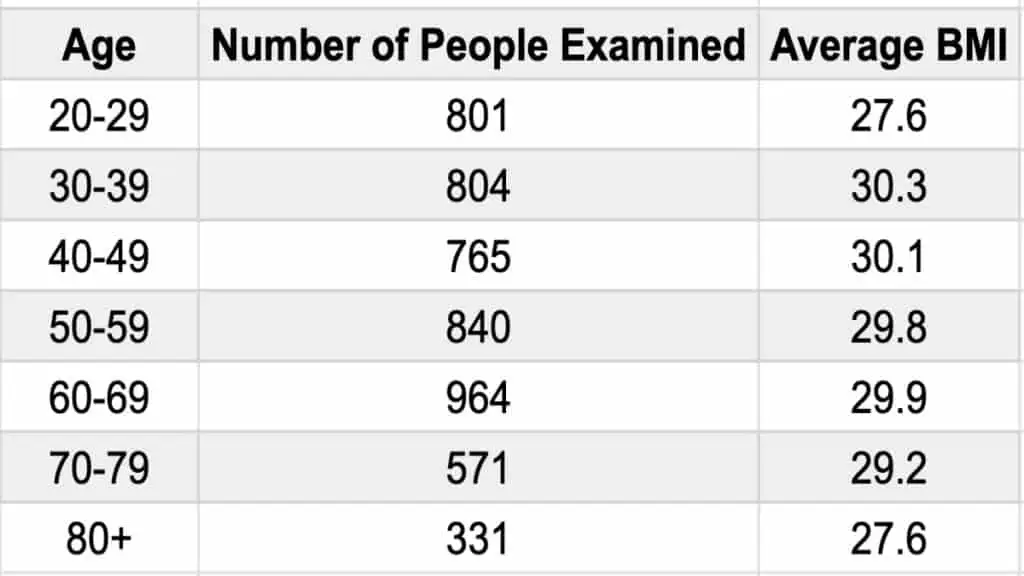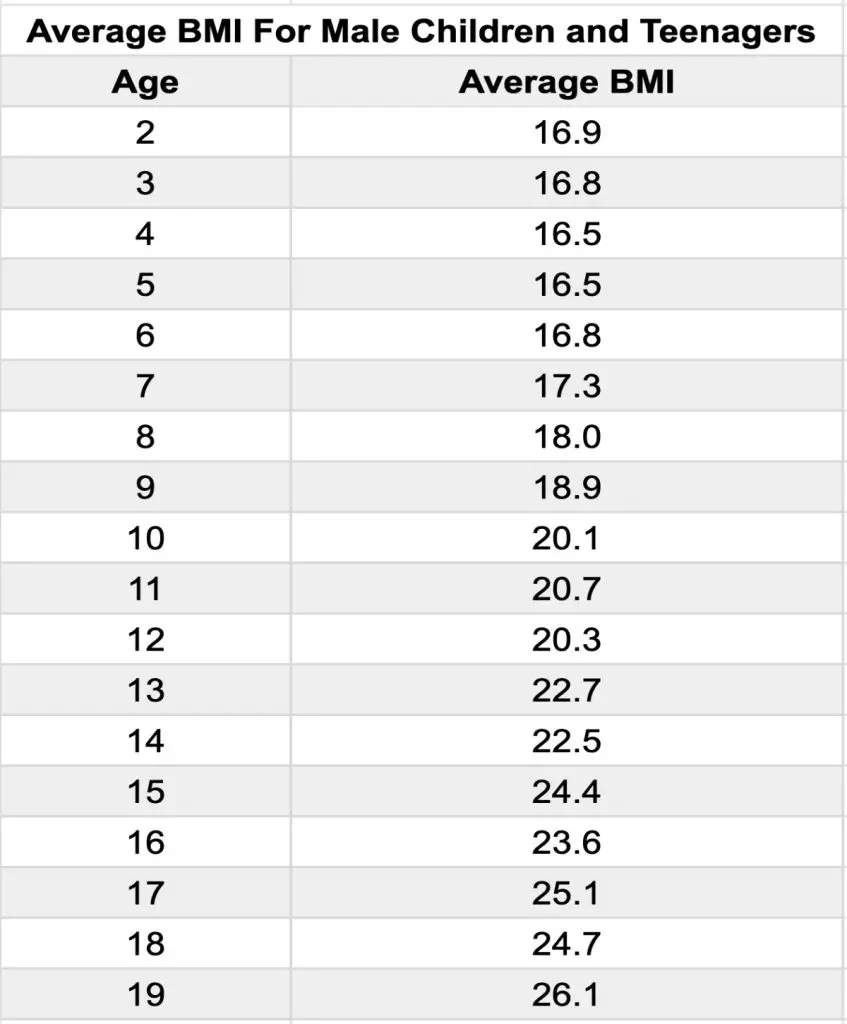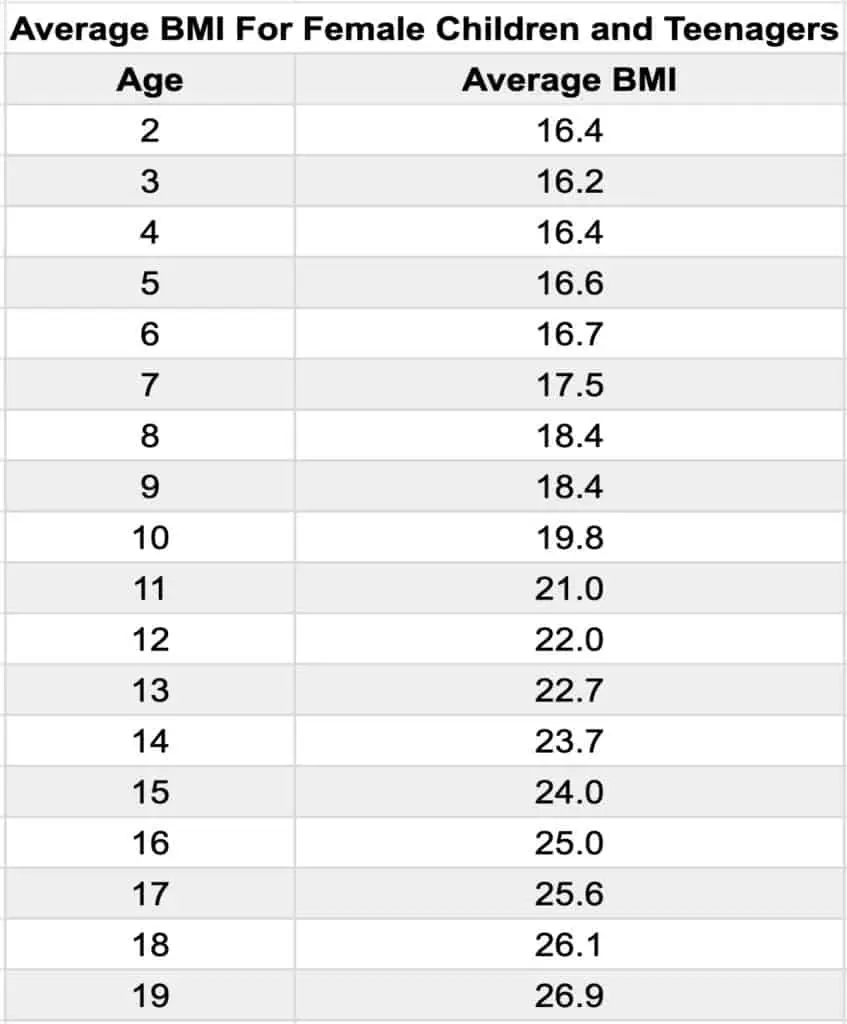The average BMI for males and females—despite being a very common body mass index score—isn’t necessarily a normal BMI for men and women.
This is because of BMI ranges. A normal BMI is another way of saying a healthy BMI. But in any given population group, an average BMI can be outside of the normal range, whether low or high.
Related:
What is the average BMI for women?

What is the average BMI for women? According to a Vital and Health Statistics report, the average female BMI is 29.8, which falls into the overweight category and is almost considered obese.
So, on average, American women have a high BMI, and, as you can see on the BMI chart for women, it’s even worse for certain age groups.
Females aged 20-29 and ladies aged 80+ both have an average body mass index of 27.6. Although not obese, this BMI is still considered overweight for adult women.
The 30-39 age group has the highest body mass index, with an average female BMI of 30.3, which is just into the obese category.
Although being obese isn’t good for your health, many people in the world struggle with their weight, so you shouldn’t be too harsh on yourself. For example, according to the World Health Organization, a staggering 40% of women in the world are overweight. [1]
What is the average BMI for men?

What is the average BMI for men? According to a recent National Health and Nutrition Examination Survey, the average male BMI is 29.4, which is considered an overweight body mass index.
As with females of the same age, young males (20-29) and elderly men (80+) have a lower average BMI (27.6) than those who are middle-aged.
This might be because young men haven’t had as much time as middle-aged men to acquire bad habits that lead to weight gain.
Similarly, most men lose muscle mass in old age, which may explain why they have a lower BMI than men in their 40s and 50s, for example.
Some men with a high BMI are actually very fit and healthy because they have minimal body fat but lots of muscle mass, which naturally causes their BMI to fall into the upper categories.
What is a healthy BMI for women?

What is a healthy BMI for women? A healthy BMI range for women is between 18.5 and 24.9. You may also hear this range referred to as the ideal BMI for women or the normal BMI range.
It’s important to note, however, that while body mass index can be a useful tool for seeing who might be at risk for disease, having a healthy BMI is no guarantee of good health.
Anthropometric measurements like waist circumference are much more effective for determining a woman’s health status because, unlike BMI, some of them measure abdominal obesity and body fat.
Compare More BMI Scores:
- BMI 14
- BMI 15
- BMI 16
- BMI 17
- BMI 18
- BMI 19
- BMI 20
- BMI 21
- BMI 22
- BMI 23
- BMI 24
- BMI 25
- BMI 26
- BMI 27
- BMI 28
- BMI 29
- BMI 30
- BMI 31
- BMI 32
- BMI 33
- BMI 34
- BMI 35
- BMI 36
- BMI 37
- BMI 38
- BMI 39
- BMI 40
- BMI 50
- BMI 70
What is a healthy BMI for men?

What is a healthy BMI for men? According to the World Health Organization, a healthy BMI for a man is between 18.5 and 24.9. [2]
Although this is a good BMI range for most men to aim for, some athletic men—especially those who lift weights with the aim of gaining muscle mass—can often have a high BMI while still being healthy.
After all, body mass index doesn’t take into account your overall body fat level, let alone crucial measurements like your waistline circumference.
Obviously, some men who have a high BMI have minimal muscle mass and lots of body fat, but you wouldn’t ever be able to tell just by their BMI score.
BMI chart for women

This BMI chart for women shows you the specific heights and weights and the corresponding BMI value.
The height (both feet and centimeters) is on top of the female BMI chart, while the weight (pounds and kilograms) is on the left-hand side.
While charts like this may not always be easy to read due to all of the numbers, it is the best way to see the BMI classification for multiple heights and weights quickly.
If you just want to find your own BMI, then your best bet is to use an online BMI calculator. There are many good ones, and most of them do the same thing—they show you your BMI as a number and give you a range or a “score.”
BMI chart for men

As you can see, this BMI chart for men is very similar (identical, actually) to the BMI chart for women. This is on purpose. Why?
Because body mass index is the same for men and women. Whether this is ideal or not is debatable.
Men usually weigh considerably more than women, and they often have larger circumference measurements as well.
This is why I always emphasize that body mass index is a useful screening tool and nothing more.
For example, if someone has a high BMI (or, ideally, if they’re on the higher end of normal), a doctor would then measure their waist to see if they have abdominal obesity, which is much worse for your health than having a high BMI.
Average BMI for children and teenagers (male)

As you can see on the male BMI chart above, the average BMI for children and teenagers greatly differs by age.
For male children and teenagers, most boys have a normal BMI until age 17, at which point the average boy registers a BMI that’s ever so slightly in the overweight category.
We can also see on the body mass index chart that males tend to have a higher BMI as they get older. Some of this is likely due to the muscle mass that a boy naturally gains during puberty.
But by the time that a boy has stopped growing (around age 17), then the additional BMI points that he typically gains could be from bad eating habits as well as weight training.
Average body mass index for children and teens (female)

The average BMI for female children and teenage girls naturally differs based on the age of the girl.
That said, there is a clear trend with female BMI; between the ages of 4 and 19, a girl’s BMI increases virtually every year.
By the time she reaches the age of 16, the average American girl is already considered overweight. Given that a girl of this age is only about 5’4, it’s likely that many teenage girls—especially those older than 16—are carrying excess body fat.
This is a worrying trend considering that childhood obesity can lead to low self-esteem, poor academic performance, and can also increase a child’s risk of developing diseases later in life. [3]
Of course, some girls (and boys) are also underweight due to their genetics, lifestyle (i.e., if they do too much exercise), or because of eating disorders.
BMI ranges for men and women
These BMI ranges for women and men are used to classify different body masses, which is useful for giving a broad overview of how heavy or light a person is for their height.
While body mass index is regularly used as a screening tool due to its ease of calculation, it’s critical to realize that BMI doesn’t measure body fat, which is its biggest limitation.
What BMI is underweight?

An underweight BMI or a low BMI is a body mass index that’s less than 18.5. Some naturally skinny individuals might have an underweight BMI while still being healthy, but a severely low BMI can be a sign that you’re unhealthy.
If someone has body image issues or an eating disorder, then they might have a low BMI due to not consuming enough calories.
Being severely underweight can weaken your immune system, lead to muscle loss, and result in malnutrition, which is why it’s recommended to aim for a weight that puts you within the BMI average.
What is a normal BMI for females and males?

A normal female BMI and a normal male BMI is between 18.5 and 24.9. This is often called the healthy BMI range, even though any BMI is no guarantee of good health.
Most people who have a normal body mass index have a fairly average body type. However, it’s possible to have a “healthy BMI” while having excess body fat, especially if you don’t have much muscle mass.
In the fitness world, this is often referred to as a “skinny fat” body type. In the clinical setting, it’s called sarcopenic obesity.
What BMI is overweight?

A body mass index is considered overweight when it’s between 25 and 29.9. Many individuals with an overweight BMI are indeed carrying excess body fat, but there are also healthy people who have a high BMI as well.
Rugby players, sprinters, and Olympic weightlifters are good examples of this kind of person.
Athletes who lift weights often have much more muscle mass than average and also have less body fat. This combination—as long as it’s not taken to the extreme—results in a healthy body but with a high BMI.
What is considered an obese BMI?

A BMI score is considered obese when it’s 30 or higher. An individual typically has to be carrying a lot of excess body fat in order to have an obese BMI.
Of course, some athletes may also have a BMI, but it’s arguable that being extremely muscular can also be unhealthy.
Body mass index FAQ
This body mass index FAQ aims to clear up some common questions that people have about BMI.
What does BMI stand for?

BMI stands for body mass index and, as the name suggests, is a screening tool that’s used to assess a person’s body weight in relation to their height.
Body mass index is broken down into four major categories; underweight, normal, overweight, and obese, although it can be further divided into other sub-categories, such as class 2 obesity, which is a BMI of 35 to 40.
What should my BMI be for my age?

There is no specific guide for BMI by age and gender because body mass index only takes a person’s height and weight into account.
That said, most people will lose muscle mass as they age, especially if they don’t discourage sarcopenia with resistance training.
As a result, elderly men and women often have a similar BMI to young men and women because they have less muscle mass than their middle-aged counterparts and, quite often, a lower body fat as well.
In contrast, middle-aged individuals tend to have more body fat than the young and elderly, which naturally results in a higher BMI.
To give an overall trend, a person’s BMI seems to increase until middle age (anywhere from 40 to 60) and then slowly decreases into old age.
Is BMI different for men and women?

Body mass index (BMI) is the same for men and women. The reason that BMI is not different for males and females is that the formula only takes into account your height and weight.
BMI doesn’t factor in your muscle mass, which men usually have more of, or your body fat, which naturally makes up more of a woman’s body. [4]
Conclusion: Is having a normal BMI enough to be healthy?

You now know the normal BMI for women and the normal BMI for men. But is having a healthy BMI actually enough to enjoy optimal health?
Health is far more complicated than a simple calculation, especially one that has many limitations like BMI.
As mentioned, you can be unhealthy while having a normal BMI and healthy while having a high BMI.
Health should be determined on a per-person basis. But if you want to get a rough estimate of your body composition, measure the circumference of your body parts instead, in particular, your waist.
References
- https://www.who.int/news-room/fact-sheets/detail/obesity-and-overweight
- Zierle-Ghosh, A., & Jan, A. (2022). Physiology, Body Mass Index. In StatPearls. StatPearls Publishing.
- Sahoo, K., Sahoo, B., Choudhury, A. K., Sofi, N. Y., Kumar, R., & Bhadoria, A. S. (2015). Childhood obesity: causes and consequences. Journal of family medicine and primary care, 4(2), 187–192. https://doi.org/10.4103/2249-4863.154628
- Nuttall F. Q. (2015). Body Mass Index: Obesity, BMI, and Health: A Critical Review. Nutrition today, 50(3), 117–128. https://doi.org/10.1097/NT.0000000000000092

